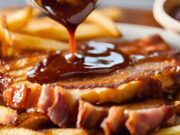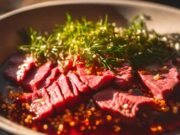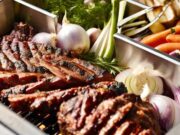When hosting the ultimate BBQ, the cut of meat you select can significantly impact the overall outcome.
From juicy steaks to tender ribs, understanding the different types of meat cuts and their qualities is essential for any grill master.
This guide provides comprehensive information, from identifying the best cuts for grilling to mastering essential preparation and cooking techniques.
Prepare to elevate your BBQ skills and impress your guests with exceptional flavors.
Key Takeaways:
- Understanding different meat cuts and their quality is crucial in selecting the perfect cut for your BBQ.
- Consider the type of cooking method and complementary flavors when choosing the right cut of meat for your BBQ.
- Proper preparation techniques and understanding different levels of doneness are essential for achieving the perfect BBQ cut of meat.
Understanding Meat Cuts
To effectively select the perfect cut of meat for your BBQ, it is essential to familiarize yourself with the various meat cuts available, which can be categorized into primal and sub-primal cuts.
Primal cuts consist of larger sections of meat, such as beef chuck or pork loin, which are further divided into specific sub-primal cuts like ribeye, sirloin, or tenderloin. Each of these cuts possesses unique qualities, including tenderness, flavor, and texture, all of which are critical to your grilling experience.
Additionally, the quality of the meat, encompassing factors such as freshness and fat content, can significantly impact the final outcome of your barbecue.
Types of Cuts: Primal and Sub-Primal
In the meat industry, primal cuts serve as the essential sections from which sub-primal cuts are derived, influencing both cooking methods and flavor profiles. Primal cuts encompass large sections such as the chuck, rib, loin, and round in beef, while sub-primal cuts refer to specific portions like ribeye, sirloin, or tenderloin. Each of these sub-primal cuts offers unique textures and flavors, determined by their marbling and fat content.
For example, the chuck primal cut is recognized for its rich flavor and produces sub-primal cuts such as chuck roast and shoulder steak, which are particularly well-suited for slow cooking techniques like braising. In pork, primal cuts like the shoulder and loin give rise to sub-primal variations such as pork chops or pulled pork. Likewise, chicken primal cuts, which include breasts and thighs, provide sub-primal cuts like chicken tenders, accommodating a variety of cooking techniques.
This highlights the significance of quality and marbling in achieving the desired textures and taste profiles in your culinary creations.
Importance of Meat Quality
Understanding the importance of meat quality is essential for achieving optimal flavors and textures in your barbecue dishes. High-quality cuts of meat, such as USDA Prime or Choice beef, are distinguished by their marbling and fat content, which contribute to tenderness and juiciness. Freshness is also a critical factor; recently butchered meat not only enhances flavor but also ensures safety during cooking. Whether you are grilling chicken, pork, or beef, prioritizing quality will significantly elevate your BBQ experience.
When considering the USDA grading systems, it is important to recognize that grades like Select indicate less marbling and flavor, making them less desirable for grilling.
To ensure you select high-quality meat, look for bright, firm textures and avoid any discoloration, as this can signify age. Checking the fat content will help you find cuts with desirable marbling that melts during cooking, adding both flavor and moisture.
By keeping these tips in mind and opting for premium options, you will not only enhance the taste of your barbecued dishes but also impress your guests with each tender, flavorful bite.
Choosing the Right Cut for Your BBQ
Selecting the appropriate cut for your BBQ is crucial, as it can greatly impact the flavor and tenderness of your meal. It is essential to explore the various options available for grilling.
Cuts such as ribeye, brisket, and pork shoulder each provide unique flavors and textures that suit different cooking techniques. Whether you aim to sear a juicy steak, prepare tender pulled pork, or serve flavorful chicken, understanding the characteristics of these cuts will elevate your grilling experience.
Furthermore, using the right marinades and spices can enhance the natural flavors of the meat, resulting in a remarkable BBQ experience.
Best Cuts for Grilling and Barbecue
In terms of grilling and barbecuing, certain cuts of meat are recognized for their flavor, tenderness, and suitability for high-heat cooking. Ribeye and brisket are excellent choices among beef cuts, known for their rich marbling and juicy texture when grilled to perfection. For those who prefer pork, pork chops and shoulder provide an exquisite taste, while chicken breast offers a lean protein option that can be enhanced with marinades and spices. Understanding the best cuts for your barbecue will help you create a delightful culinary experience.
Selecting the right meat cuts not only improves the grilling outcome but also plays a crucial role in crafting memorable meals. For example, the ribeye, celebrated for its buttery flavor, excels when seared over high heat, while brisket, though tougher, transforms into an incredibly tender dish through low and slow cooking techniques. Similarly, when marinated, pork chops can absorb a wide range of flavors, making them a favorite for grilling. Additionally, chicken thighs, often overlooked, present a fantastic alternative to breasts due to their richer taste and juiciness.
When utilized effectively, marinades contribute to tenderizing the meat while infusing it with herbs, citrus, or bold spices. This elevates the overall flavor profile, ensuring that each bite is mouthwatering.
Complementary Flavors and Marinades
The right complementary flavors and marinades can significantly enhance your BBQ by accentuating the natural taste of the meat, whether you are grilling beef, pork, or chicken. Marinades that combine spices, oils, and acidic ingredients such as vinegar or citrus can penetrate the meat, adding depth and complexity to each bite. By understanding the specific flavor profiles of different cuts, you can create marinades that highlight the best qualities of your BBQ, resulting in an unforgettable meal.
For example, a rich and marbled ribeye steak pairs exceptionally well with a marinade that includes garlic, rosemary, and balsamic vinegar, allowing the robust flavors to meld seamlessly during the grilling process. When preparing pork, consider a sweet and tangy marinade featuring apple cider vinegar, brown sugar, and mustard for cuts like tenderloin, as this will enhance the meat’s subtle sweetness.
Chicken, on the other hand, thrives with citrus-based marinades, where lemon or lime juice, combined with herbs like thyme or oregano, can create remarkable results. The ideal marinating times vary: tougher cuts like beef benefit from a longer soak of 4 to 12 hours, while chicken and pork can achieve excellent results with just 1 to 4 hours of marination. This approach allows the flavors to unite and results in a truly mouthwatering experience.
Preparation and Cooking Techniques
Effective preparation and cooking techniques are essential for achieving perfectly cooked meat on the grill, ensuring that your BBQ is both tender and flavorful. Techniques such as basting and searing can enhance the outer crust of the meat while preserving its juiciness on the inside.
Additionally, understanding the appropriate internal temperatures for different types of meat—whether you are grilling beef, pork, or chicken—is crucial for maintaining food safety and quality. Incorporating methods such as sous vide can also be a significant advantage in achieving consistent results.
Essential Meat Preparation Techniques
Essential meat preparation techniques are crucial for ensuring that your BBQ turns out succulent and full of flavor. Whether you are marinating, seasoning, or tenderizing, each method plays a significant role in the overall quality of the meat. Marinating not only infuses the meat with flavor but also helps to break down tough fibers, enhancing tenderness. By understanding the appropriate techniques for each type of meat, you can significantly elevate your grilling experience.
For example, when marinating beef cuts like flank or skirt steak, using a mixture that includes acidic ingredients such as vinegar or citrus juice can help soften the meat while adding depth to its flavor profile. Similarly, pork tenderloin benefits from a spice rub that highlights earthy notes, creating a flavorful crust while allowing the natural sweetness of the meat to shine. Chicken also responds well to both wet and dry marinades, especially when seasoned with herbs and spices that complement its mild flavor.
Utilizing these methods not only enhances taste but also transforms the overall texture, resulting in a juicy, mouthwatering finish on the grill.
Grilling and Searing Basics
Grilling and searing are foundational techniques that every BBQ enthusiast should master to achieve the perfect crust and flavor on meat. Searing involves cooking meat at high temperatures to create a caramelized exterior, while grilling allows for the infusion of smoky flavors, particularly when using charcoal. Understanding the appropriate temperatures and techniques for searing various cuts of meat is essential for achieving the desired levels of doneness and ensuring that juices are locked in.
Temperature control is critical in both methods; excessive heat can lead to dryness, while undercooking can pose food safety risks. Charcoal grilling typically provides a deeper, more robust smoky flavor due to the natural combustion of the wood, making it a preferred choice for many traditionalists. Conversely, gas grilling offers convenience and precise temperature control, making it easier to manage cooking times.
For the perfect sear, consider preheating the grill before adding your protein and using a cast-iron skillet for more even heating. By taking these factors into account, you can significantly enhance your overall grilling experience.
Understanding Different Levels of Doneness
Understanding the various levels of doneness is essential for achieving perfectly cooked meat that aligns with your preferences while ensuring food safety. Each type of meat—beef, pork, or chicken—has specific internal temperature guidelines that indicate its doneness. For instance, medium-rare beef is typically cooked to an internal temperature of around 130-135°F, while chicken must reach a minimum of 165°F to ensure safety. Familiarizing yourself with these levels will enable you to serve tender, juicy meat that is cooked to perfection.
Along with these temperatures, visual indicators can also assist you in assessing doneness. A perfectly cooked steak, for example, will display a warm, red center for medium-rare, while pork should exhibit a slight hint of pink when it reaches medium.
Utilizing a reliable meat thermometer is crucial, as it eliminates the guesswork from cooking and ensures that the appropriate temperatures are achieved. This tool provides reassurance, confirming that the meat is both delicious and safe for consumption, thereby allowing hosts to enjoy mealtime without concern.
Frequently Asked Questions
What should I consider when selecting the perfect cut of meat for my BBQ?
When selecting a cut of meat for your BBQ, it’s important to consider the type of meat, the tenderness, the marbling, and the thickness of the cut.
Which type of meat is best for BBQ?
The best types of meat for BBQ include beef, pork, chicken, and lamb. These meats are flavorful and have the right amount of fat to keep them juicy on the grill.
What cuts of beef are ideal for BBQ?
Some of the best cuts of beef for BBQ include ribeye, brisket, and sirloin. These cuts are flavorful and tender, making them perfect for grilling.
How important is marbling in a cut of meat for BBQ?
Marbling, or the visible fat within the muscle, is crucial for a perfect BBQ cut. It adds flavor and moisture to the meat, making it tender and juicy when cooked.
Is thickness important when selecting a cut of meat for BBQ?
Yes, thickness is important when selecting a cut of meat for BBQ. Thicker cuts take longer to cook and may require different grilling techniques, while thinner cuts are faster to cook and can be more prone to drying out.
What is the best way to ensure my BBQ meat is tender and juicy?
The best way to ensure tender and juicy BBQ meat is to let it rest after cooking. This allows the juices to redistribute throughout the meat, resulting in a more flavorful and moist final product.


















































